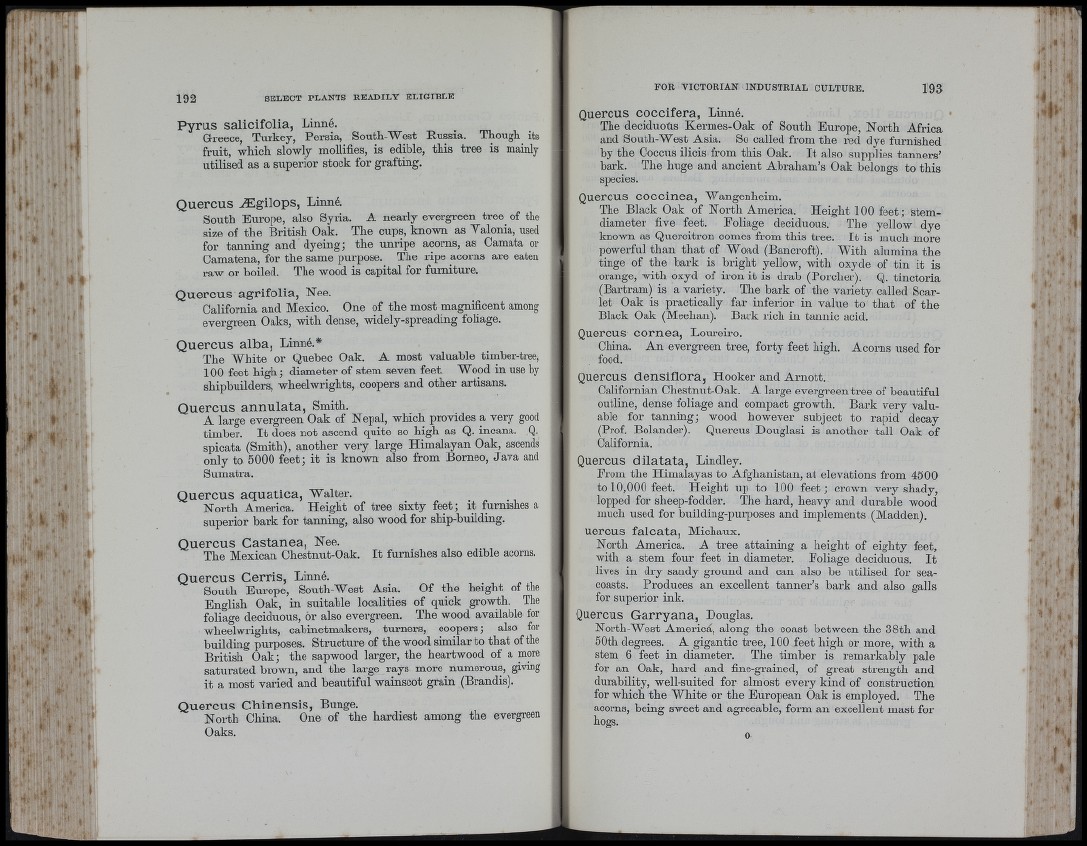
Pyrus salicifolia, Linné.
Greece, Turkey, Persia, South-West Russia. Though its
fruit, which slowly mollifies, is edible, this tree is mainly
utilised as a superior stock for grafting.
Quercus Ægilops, Linné.
South Europe, also Syria. A nearly evergreen tree of tlie
size of the British Oak. The cups, known as Yalonia, used
for tanning and dyeing; the unripe acorns, as Camata or
Camatena, for the same purpose. The ripe acorns are eaten
raw or boiled. Tbe wood is capital for furniture.
Quercus agrifolia, Nee.
California and Mexico. One of the most magnificent among
evergreen Oaks, with dense, widely-spreading foliage.
Quercus alba, Linné.*
Tbe White or Quebec Oak. A most valuable timber-tree,
100 feet high; diameter of stem seven feet. Wood in use by
shipbuilders, wheelwrights, coopers and otber artisans.
Quercus annulata, Smith.
A large evergreen Oak of Nepal, which provides a very good
timber. I t does not ascend quite so high as Q. incana. Q.
spicata (Smith), another very large Himalayan Oak, ascends
only to 5000 feet; it is known also from Borneo, Java and
Sumatra.
Quercus aquatica, Walter.
North America. Height of tree sixty feet; it furnishes a
superior bark for tanning, also wood for sbip-building.
Quercus Castanea, Nee.
The Mexican Cbestnut-Oak. I t furnishes also edible acorns.
Quercus Cerris, Linné.
South Europe, South-West Asia. Of the height of the
English Oak, in suitable localities of quick growth. The
foliage deciduous, or also evergreen. The wood available for
wheelwrights, cabinetmakers, turners, coopers; also for
building purposes. Structure of tbe wood similar to that of the
British Oak; the sapwood larger, tbe beartwood of a more
saturated brown, and the large rays more _ numerous, giving
it a most varied and beautiful wainscot grain (Brandis).
Quercus Cbinensis, Bunge.
North China. One of the hardiest among the evergreen
Oaks.
Quercus c o c c if e r a , Linné.
The deciduous Kermes-Oak of South Europe, North Africa
and South-West Asia. So called from the red dye furnished
by the Coccus ilicis from this Oak. I t also supplies tanners’
bark. The huge and ancient Abraham’s Oak belongs to this
species.
Quercus c o c c in e a , Wangenheim.
The Black Oak of North America. Height 100 feet; stem-
diameter five feet. Foliage deciduous. The yellow dye
known as Quercitron comes from this tree. I t is much more
powerful than th a t of Woad (Bancroft). With alumina the
tinge of the bark is bright yellow, with oxyde of tin it is
orange, with oxyd of iron it is drab (Porcher). Q. tinctoria
(Bartram) is a variety. The bark of the variety called Scarlet
Oak is practically far inferior in value to th a t of the
Black Oak (Meehan). Bark rich in tannic acid.
Quercus cornea, Loureiro.
China. An evergreen tree, forty feet high. Acorns used for
food.
Quercus densiflora. Hooker and Arnott.
Californian Chestnut-Oak. A large evergreen tree of beautiful
outline, dense foliage and compact growth. Bark very valuable
for tanning; wood however subject to rapid decay
(Prof. Bolander). Quercus Douglasi is another tall Oak of
California.
Quercus dilatata, Lindley.
From the Himalayas to Afghanistan, at elevations from 4500
to 10,000 feet. Height up to 100 feet; crown very shady,
lopped for sheep-fodder. The hard, heavy and durable wood
much used for building-purposes and implements (Madden).
uercus falcata, Michaux.
North America. A tree attaining a height of eighty feet,
with a stem four feet in diameter. Foliage deciduous. I t
lives in dry sandy ground and can also be utilised for sea-
coasts. Produces an excellent tanner’s bark and also galls
for superior ink.
Quercus Garryana, Douglas.
North-West America, along the coast between tbe 38th and
50th degrees. A gigantic tree, 100 feet high or more, with a
stem 6 feet in diameter. The timber is remarkably pale
for an Oak, hard and fine-grained, of great strength and
durability, well-suited for almost every kind of construction
for which the White or the European Oak is employed. The
acorns, being sweet and agreeable, form an excellent mast for
hogs.
o
a i '1
7 | ; :
I ' I
I '